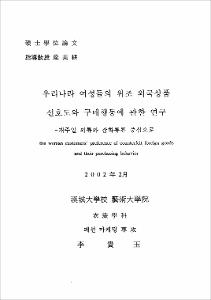우리나라 여성들의 위조 외국상품 선호도와 구매행동에 관한 연구
= (The) woman customers' preference of counterfeit foreign goods and their purchasing behavior : focusing oncasual wear and miscellanecous goods
- Alternative Title
- 캐주얼 의류와 잡화류를 중심으로
- Abstract
- The purpose of this study is to conduct a research to find out the brands customers owns for certain type of items, and reveal the customers' preference of counterfeit foreign goods and their purchasing behavior by demographic information such as age, education, resident area, profession and level of income.
The conclusions are as follows.
First, the brand that the largest number of customers own is a foreign brand Burberrys. Louis Voitton and Polo are the next in place. The most popular type of items the customers have counterfeits is shirts. The next popular items are bags, handbags and pants, in the order of popularity.
Second, customers are satisfied with the price of counterfeit brand products, but they gave negative responses towards the quality and the service of these products. The customers are familiar with counterfeit foreign goods and do not consider the sales of counterfeits to be wrongful. The largest group of interviewees is the single female aged from teens to twenties who has received more than high school education.
Third, the important factors in making purchase decisions regarding clothing are design, practicality, price and brand, in the order of importance. The largest purchase motivations of casual wear is to find a match for clothing that the customers already have, and the next largest motivation is that the customers actually need to buy clothing.
Fourth, based on factor analysis, the degree of preference is determined by the Factor 1-1(design and brand image) and Factor 1-2(urge, material, cognition, familiarity, price, one-time event and satisfaction). Based on factor analysis of purchase behavior, purchase behavior is determined by four factors, namely, design and color, quality, prestige and economic reasons, and satisfaction.
The result of linear regression analysis on these factors indicate that the Factor 1-1(design and brand image) influence the Factor 2-1(quality). Moreover, the level of income influences Factor 2-2(design and color), Factor 2-3(prestige and economic reasons) and Factor 2-4(satisfaction). The number of brands the customer owned influence Factor 1-1(design and brand image) and Factor 2-1(quality). The number of counterfeit brands the customers owned influence Factor 2-3(prestige and economic reasons). The preference factor, Factor 1-1(design and brand image) influences Factor 2-4(satisfaction)
- Issued Date
- 2002
- Type
- Thesis
- Files in This Item:
-
-
Download
 000000066481.pdf
기타 데이터 / 1.89 MB / Adobe PDF
000000066481.pdf
기타 데이터 / 1.89 MB / Adobe PDF
-
Items in Repository are protected by copyright, with all rights reserved, unless otherwise indicated.